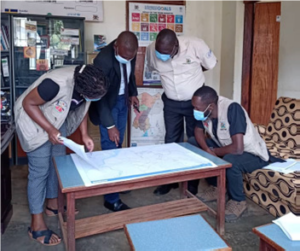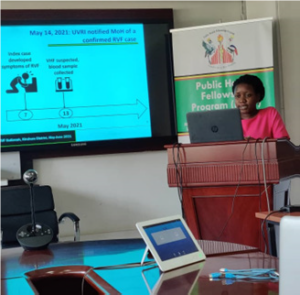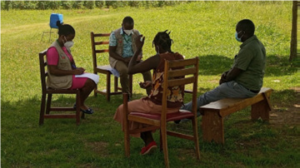 |
Hildah Tendo NansikombiBMLS (MUST), MCEB (MAK), Advanced-FETP (UPHFP) Host Site: Department of Integrated Epidemiology, Surveillance and Public
|
||||||
ABOUT THE FELLOWHildah Tendo Nansikombi is a field epidemiologist with a Master of science in Clinical Epidemiology and Biostatistics, and a background in Medical Laboratory Science. Before the fellowship, she worked with the Uganda Ministry of Health as an Epidemiologist during the COVID-19 response. During her time as a fellow, she was attached to the Department of Integrated Epidemiology, Surveillance and Public Health Emergencies (IES&PHE), Ministry of Health.At IES & PHE she developed skills in surveillance and response coordination. She was an editor, and drafted reports in the National Weekly Epidemiological, and National Institute of Public Health (UNIPH) bulletins.She led projects on a Rift Valley Fever Outbreak, COVID-19 vaccine uptake among people with non-communicable diseases and improving weekly surveillance reporting on epidemic prone diseases in Jinja District. She also actively participated in eleven other investigations of public health importance. These engagements coupled with surveillance and preparedness strengthening sharpened her knowledge on International Health Regulations (IHR), and Integrated Disease Surveillance and Response (IDSR) implementation in Uganda. She has advanced her understanding of Uganda’s health information systems and their role in guiding public health interventions. Routine surveillance data analysis polished her skills in using data collection tools like ODK, KoboCollect and statistical packages like STATA, EpiInfo and QGIS. Achievements at the Host Site
Fellowship program specific achievements
Written Communication
Conference presentations
Summary of Epidemiological Study:Title: Human and Animal Rift Valley Fever outbreak investigation, Uganda Public Health Fellowship Program – Field Epidemiology Track – Cohort 2021 Graduation 7 Kiruhura District, Uganda, May–June, 2021 Background: Rift valley fever (RVF) is an endemic viral zoonosis in Uganda. Sporadic outbreaks have been reported to occur in the cattle corridor. On May 14, 2021, a 19-year-old female from Kasaana Village, Kiruhura District died; testing by reverse transcription polymerase chain reaction (RT-PCR) was positive for RVF. We investigated to determine the magnitude of the outbreak, source of infection, and recommend evidence-based control measures. Methods: A confirmed case was defined as detection of RVF virus nucleic acid by RT-PCR or serum IgM antibodies by enzyme-linked immunosorbent assay (ELISA) in a resident of/visitor to Kasaana Village from April 24-June 24, 2021. We tested blood samples from 25 persons (3 with RVF symptoms, 2 neighbors of the index case, and 20 randomly-selected villagers) using RT-PCR or ELISA, and 57 livestock (33 randomly-selected cows and 24 goats from 4 village farms reporting any animals with RVF symptoms) by ELISA. We collected data on demographics, history of RVF symptoms, and animal-related activities. We characterized cases epidemiologically. Results: We identified 6 confirmed case-patients in Kasaana village (2 RT-PCR-positive, 4 IgM-positive); one died (case fatality rate=17%). Four (67%) were female; median age was 23 years (range, 19–42 years). All cases kept cows and goats. Two case-patients reported headache, fever, and hematemesis. The index case-patient, who milked cows on her family farm, had hemorrhagic symptoms consistent with RVF starting 1 week before death. She presented to six health facilities during that week but was only diagnosed after death. Eight case animals; three (9%) cows and five (21%) goats were IgM-seropositive for RVF. Conclusion: This RVF outbreak likely resulted from contact with infected animal products. Earlier diagnosis might have prevented the index case-patient’s death. We conducted health education among Kasaana villagers, and recommended training of health workers at facilities within the region to emphasize the importance of early diagnosis of haemorrhagic fevers. Key lessons learnt during the fellowship
|
|||||||
|
|
|
|
|
|
|
|
|





